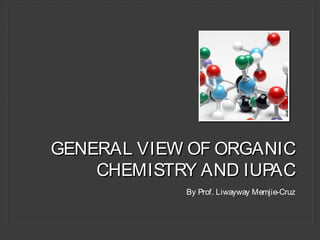
General view of organic chemistry and iupac
- 1. GENERAL VIEW OF ORGANICGENERAL VIEW OF ORGANIC CHEMISTRY AND IUPACCHEMISTRY AND IUPAC By Prof. Liwayway Memjie-Cruz
- 3. the chemistry subdisciplinefor thescientific study of structure, properties, and reactionsof organic compoundsand organic materials(materialsthat contain carbon atoms). study of structuredeterminestheir chemical composition and formula. study of propertiesincludesphysical and chemical properties, and evaluation of chemical reactivity to understand their behavior. study of organic reactionswhich includesthechemical synthesisof natural products, drugs, and polymers, and study of individual organic moleculesin thelaboratory and through theoretical study.
- 4. ORGANIC COMPOUNDSORGANIC COMPOUNDS Carbohydrates, Proteins and Fats
- 6. havesomevery peculiar characteristicsand propertieswhen it comesto thekind of chemical reactionsthey undergo. havevery wideapplicationsin thechemical and pharmaceutical industries havetheability to go into reactionsand form other compounds and mixtures.
- 8. Carbon atomsform stable covalent bondswith one another. A carbon-carbon single covalent bond hasenergy of 346 kJmol-1. which indicates strong bond. stablebecauseof thestrong carbon-carbon bonds. do not ionizein solution and are non-conductorsof electricity.
- 9. Carbon-hydrogen bondsare, non-polar, likethecarbon- carbon bondsbecauseof the almost equal electronegativitiesof thetwo elements. they cannot form bondswith water moleculesand are insolublein water. held together only by weak intermolecular forcessuch as thevan der Waalsforces, and so they can intermingleeasily. dissolveonly in non-polar solventslikebenzeneor ether.
- 10. generally havelower melting and boiling pointsthan inorganic compounds becausethesecompounds possessrelatively weak intermolecular bondswhich can beeasily broken by heat energy. Many of them, thosewith low relativemolecular massestend to bevolatile and boil at temperatures below 300o C.
- 11. arethermally unstable, decomposing into simpler moleculeswhen heated to temperaturesabove500oC. however, thisproperty is sometimesof commercial importanceasin the cracking of petroleum which isvery useful in the fractional distillation.
- 12. areflammableand born exothermically in a plentiful supply of air to yield carbon(IV) oxide and water. most fuelssuch aswood, coal, oil, petrol and natural gasareorganic and their combustion providesour main source of heat energy.
- 13. Reactionstend to be much slower than the ionic reactions. Reactionsusually requireheating, thoroughly mixing and catalyst to speed up thereaction.
- 15. ORGANIC (with carbon) DNA tablesugar or sucrose, C12H22O11 benzene, C6H6 methane, CH4 ethanol or grain alcohol, C2H6O INORGANIC (w/o carbon) tablesalt or sodium chloride, NaCl carbon dioxide, CO2 diamond (pure carbon) silver sulfur
- 17. saturated hydrocarbons meansfully filled and can also bereferred to asalkanes. havethehighest number of hydrogen atoms, which a moleculecan accommodate. bondsbetween carbon atomsand hydrogensaresingle bonds. Becauseof that thebond rotation isallowed between any atoms. simplest typeof hydrocarbons. Saturated hydrocarbons havethegeneral formulaof CnH2n+ 2. astateof asolution whereno moresolutecan be dissolved in it. In other words, maximum amount of soluteisdissolved in thesolvent.
- 18. namesof thestraight chain saturated hydrocarbonsfor up to a10 carbon chain. Thenamesof the substituentsisformed by theremoval of one hydrogen from theend of thechain isobtained by changing thesuffix -aneto -yl.
- 19. Theword “unsaturated” givesthemeaning of “not fully filled.” So it hastheoppositemeaning of saturate. therearedoubleor triplebondsbetween thecarbon atoms. Sincetherearemultiplebonds, theoptimal number of hydrogen atomsisnot therein themolecule. Alkenesand alkynesareexamplesfor unsaturated hydrocarbons. Non cyclic moleculeswith doublebondshavethe general formulaof CnH2n., and alkyneshavethegeneral formulaof CnH2n-2.
- 21. theuniversally-recognized authority on chemical nomenclatureand terminology and two IUPAC bodiestakeleading rolesin thisactivity: Division VIII – Chemical Nomenclatureand StructureRepresentati and the Inter-divisional Committeeon Terminology, Nomenclature, and Sy .
- 22. asystematic method of naming organic chemical compoundsasrecommended[ by the International Union of PureandApplied Chemistry (IUPAC). It ispublished in the No menclature o f Organic Chemistry (informally called theBlueBook). Ideally, every possibleorganic compound should haveanamefrom which an unambiguous structural formulacan becreated.
- 23. A rational nomenclaturesystem should do at least two things: 1. it should indicatehow thecarbon atomsof a given compound arebonded together in a characteristic latticeof chainsand rings. 2. it should identify and locateany functional groupspresent in thecompound. Sincehydrogen issuch acommon component of organic compounds, itsamount and locationscan be assumed from thetetravalency of carbon, and need not bespecified in most cases.
- 24. aset of logical rulesdevised and used by organic chemiststo circumvent problems caused by arbitrary nomenclature. Knowing theserulesand given astructural formula, one should beableto writeauniquenamefor every distinct compound. Likewise, given a IUPAC name, oneshould beableto writea structural formula.
- 25. 1. A root or baseindicating amajor chain or ring of carbon atomsfound in themolecular structure. 2. A suffix or other element(s) designating functional groupsthat may bepresent in the compound. 3. Namesof substituent groups, other than hydrogen, that completethemolecular structure.
- 26. TheIUPAC Color Booksaretheworld’s authoritativeresourcefor chemical nomenclature, terminology, and symbols. Terminology definitionspublished by IUPAC aredrafted by international committeesof expertsin theappropriatechemistry sub- disciplines, and ratified by IUPAC’s Interdivisional Committeeon Terminology, Nomenclatureand Symbols(ICTNS).
- 27. Chemical Terminology (Gold book) Quantities, Unitsand Symbolsin Physical Chemistry (Green Book) Nomenclatureof Inorganic Chemistry (Red Book) Nomenclatureof Organic Chemistry (BlueBook) Compendium of Polymer Terminology and Nomenclature (Purplebook) Analytical Nomenclature(Orangebook) Compendium of Terminology and Nomenclatureof Properties Clinical Laboratory Sciences(Silver book) Biochemical Nomenclature(WhiteBook)
- 28. https://chem.libretexts.org/Textbook_Maps/General_Chemistry/Map%3A_G https://gulpmatrix.com/characteristics-organic-compounds/ https://drawinglics.com/photos/2057691/what-is-an-organic-compound- what-are-organic-compounds-edu-what-is-an-organic-compound.py https://www.dur.ac.uk/chemistry/outreach/dusting/students/synthesis/ https://slideplayer.com/slide/4401322/ https://iupac.org/what-we-do/nomenclature/ http://www.chem.uiuc.edu/GenChemReferences/nomenclature_rules.htm l https://drawinglics.com/s/iupac-naming.py https://iupac.org/what-we-do/books/color-books/
